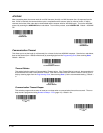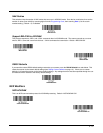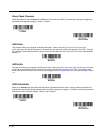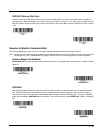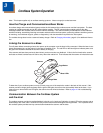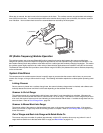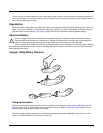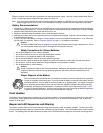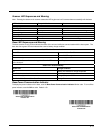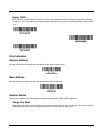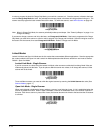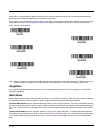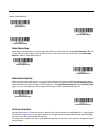
3 - 4
Place the scanner in the base that is connected to an appropriate power supply. Use only a Listed Limited Power Source
(LPS) or Class 2 type power supply with output rated 5 to 5.2Vdc, 1A.
Note: If you are powering the base through the interface cable (for example, a USB cable) and not using an external power
supply plugged into the aux port, the current available for charging is reduced and the charge time is increased.
Battery Recommendations
• The battery is a lithium ion cell and can be used without a full charge, and can also be charged without fully discharging,
without impacting the battery life. There is no need to perform any charge/discharge conditioning on this type of battery.
• Keep the base connected to power when the host is not in use.
• Replace a defective battery immediately since it could damage the scanner.
• Although your battery can be recharged many times, it will eventually be depleted. Replace it after the battery is unable
to hold an adequate charge.
• If you are not sure if the battery or charger is working properly, send it to Honeywell International Inc. or an authorized
service center for inspection. Refer to Customer Support on page 13-1 for additional information.
Caution:
The model CCB00-010BT base is designed for use with the Honeywell model Voyager 1202g scanner. Use of
any non-Honeywell battery may result in damage not covered by the warranty.
Safety Precautions for Lithium Batteries
• Do not place batteries in fire or heat the batteries.
• Do not store batteries near fire or other high temperature locations.
• Do not store or carry batteries together with metal objects.
• Do not expose batteries to water or allow the batteries to get wet.
• Do not connect (short) the positive and negative terminals, of the batteries, to each other with any metal object.
• Do not pierce, strike or step on batteries or subject batteries to strong impacts or shocks.
• Do not disassemble or modify batteries.
Caution:
Danger of explosion if batteries are incorrectly replaced. Dispose of used batteries according to the recycle
program for batteries as directed by the governing agency for the country where the batteries are to be
discarded.
Proper Disposal of the Battery
When the battery has reached the end of its useful life, the battery should be disposed of by a qualified
recycler or hazardous materials handler. Do not incinerate the battery or dispose of the battery with gen-
eral waste materials. You may send the scanner’s battery to us. (postage paid). The shipper is responsi-
ble for complying with all federal, state, and local laws and regulations related to the packing, labeling,
manifesting, and shipping of spent batteries. Contact the Product Service Department (page 13-1) for
recycling or disposal information. Since you may find that your cost of returning the batteries significant,
it may be more cost effective to locate a local recycle/disposal company.
Flash Updates
The scanner can be flashed either in the base or out of the base, however, it is recommended that you flash the scanner while it
is in the base. Flash updates cannot be completed when the scanner is out of the base and the battery is low, or when the
scanner is out of range.
Beeper and LED Sequences and Meaning
The scanner contains LEDs on the top that indicate linking status, decoding state, and battery condition. The base has LEDs
on the front that indicate its power up, communication, and battery charge condition. The unit’s audible indicators have meaning
as well. The following table lists the indication and cause of the LED illumination and beeps for the scanner and charge base.
!
!



